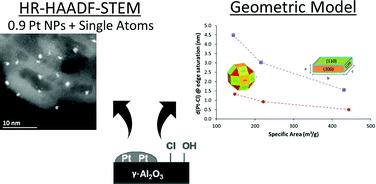Our official English website, www.x-mol.net, welcomes your
feedback! (Note: you will need to create a separate account there.)
Evaluating acid and metallic site proximity in Pt/γ-Al2O3–Cl bifunctional catalysts through an atomic scale geometrical model
Nanoscale ( IF 5.8 ) Pub Date : 2022-05-31 , DOI: 10.1039/d2nr00261b Ana T F Batista 1 , Céline Chizallet 1 , Fabrice Diehl 1 , Anne-Lise Taleb 1 , Anne-Sophie Gay 1 , Ovidiu Ersen 2 , Pascal Raybaud 1
Nanoscale ( IF 5.8 ) Pub Date : 2022-05-31 , DOI: 10.1039/d2nr00261b Ana T F Batista 1 , Céline Chizallet 1 , Fabrice Diehl 1 , Anne-Lise Taleb 1 , Anne-Sophie Gay 1 , Ovidiu Ersen 2 , Pascal Raybaud 1
Affiliation

|
Quantifying the distances between metallic sites and acid sites is crucial for tuning the catalytic activity and selectivity of bifunctional catalysts involving sub-nanometric platinum (Pt) nano-particles (NP) highly dispersed on a chlorinated alumina support. Thanks to the quantitative use of high resolution scanning transmission electron microscopy in the high angle annular dark field mode, we first highlight the presence of few Pt NP together with Pt single atoms (SA) on γ-alumina supports exhibiting various morphologies (flat-like or egg-like), and chlorine (Cl) and Pt loadings. We demonstrate that increasing the Pt loading does not impact the NP sizes but only the Pt NP inter-distances, whereas the Cl loading influences the SA/NP proportion. Then, we establish a thorough geometrical model which accounts for the way in which the global average metallic – acid inter-site distances evolve from 1 nm to 6 nm as a function of three key physico-chemical descriptors: alumina morphologies, chlorine contents and size factor of alumina particles (directly linked to specific surface area). Considering that Cl is predominantly located at alumina crystallite edges, the morphology strongly impacts the Cl edge saturation: 0.4% for flat-like, and 1.2% for egg-like alumina at fixed specific surface area (∼200 m2 g−1). At Cl edge saturation, the inter-site distance is found to be 3 nm for flat-like, and 1 nm for egg-like alumina. However, for fixed Cl loading, the inter-site distance is less discriminated by the morphology. We discuss these trends in the case of naphtha reforming catalysts and thanks to the as-obtained geometrical model, we identify the key alumina descriptors to tune the inter-site distance.
中文翻译:

通过原子尺度几何模型评估 Pt/γ-Al2O3-Cl 双功能催化剂中酸和金属位点的接近性
量化金属位点和酸性位点之间的距离对于调整双功能催化剂的催化活性和选择性至关重要,这些催化剂涉及高度分散在氯化氧化铝载体上的亚纳米铂 (Pt) 纳米颗粒 (NP)。由于在高角度环形暗场模式下定量使用高分辨率扫描透射电子显微镜,我们首先强调了在 γ-氧化铝载体上存在少量 Pt NP 和 Pt 单原子 (SA),表现出各种形态(扁平状或蛋状),以及氯 (Cl) 和 Pt 负载。我们证明增加 Pt 负载不会影响 NP 大小,而只会影响 Pt NP 间距,而 Cl 负载会影响 SA/NP 比例。然后,我们建立了一个完整的几何模型,该模型解释了全球平均金属-酸位点间距离从 1 nm 演变为 6 nm 的方式,这是三个关键物理化学描述符的函数:氧化铝形态、氯含量和尺寸因子氧化铝颗粒(与比表面积直接相关)。考虑到 Cl 主要位于氧化铝微晶边缘,形态强烈影响 Cl 边缘饱和度:扁平状氧化铝为 0.4%,在固定比表面积(~200 m2g -1 )。在 Cl 边缘饱和时,发现平面状氧化铝的点间距离为 3 nm,蛋状氧化铝为 1 nm。然而,对于固定的 Cl 负载,站点间距离受形态的影响较小。我们在石脑油重整催化剂的情况下讨论了这些趋势,并且由于获得的几何模型,我们确定了关键的氧化铝描述符来调整站点间距离。
更新日期:2022-05-31
中文翻译:

通过原子尺度几何模型评估 Pt/γ-Al2O3-Cl 双功能催化剂中酸和金属位点的接近性
量化金属位点和酸性位点之间的距离对于调整双功能催化剂的催化活性和选择性至关重要,这些催化剂涉及高度分散在氯化氧化铝载体上的亚纳米铂 (Pt) 纳米颗粒 (NP)。由于在高角度环形暗场模式下定量使用高分辨率扫描透射电子显微镜,我们首先强调了在 γ-氧化铝载体上存在少量 Pt NP 和 Pt 单原子 (SA),表现出各种形态(扁平状或蛋状),以及氯 (Cl) 和 Pt 负载。我们证明增加 Pt 负载不会影响 NP 大小,而只会影响 Pt NP 间距,而 Cl 负载会影响 SA/NP 比例。然后,我们建立了一个完整的几何模型,该模型解释了全球平均金属-酸位点间距离从 1 nm 演变为 6 nm 的方式,这是三个关键物理化学描述符的函数:氧化铝形态、氯含量和尺寸因子氧化铝颗粒(与比表面积直接相关)。考虑到 Cl 主要位于氧化铝微晶边缘,形态强烈影响 Cl 边缘饱和度:扁平状氧化铝为 0.4%,在固定比表面积(~200 m2g -1 )。在 Cl 边缘饱和时,发现平面状氧化铝的点间距离为 3 nm,蛋状氧化铝为 1 nm。然而,对于固定的 Cl 负载,站点间距离受形态的影响较小。我们在石脑油重整催化剂的情况下讨论了这些趋势,并且由于获得的几何模型,我们确定了关键的氧化铝描述符来调整站点间距离。











































 京公网安备 11010802027423号
京公网安备 11010802027423号